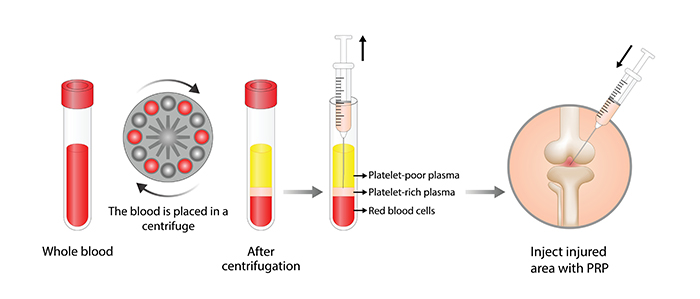Platelet Rich Plasma (PRP) for Knee Injuries
PRP is a revolutionary treatment that harnesses the power of the patient’s own blood platelets to promote healing and tissue regeneration. Knee pain is one of the most common symptoms in athletes from strained ligaments, cartilage tears, and tendonitis to people over age 50 with knee arthritis. PRP injections could provide improved pain relief and reduce inflammation improving functional outcomes. Traumatic soft tissue injuries and degenerative conditions such as degenerative meniscus lesions may benefit from Platelet-rich plasma injections.
Platelet rich plasma therapy for knee injuries typically includes osteoarthritis to the knee, tendon injuries such as the patellar tendon and ligament injuries specifically ACL ligament tears. PRP for knee OA has been widely investigated with an overly positive outcome and significant improvement in symptoms.
PRP (Platelet-Rich Plasma) is a regenerative medicine therapy that involves the use of a patient’s own blood plasma to promote healing and regeneration of tissues. Blood is composed of several components, including red blood cells, white blood cells, plasma, and platelets.
Platelets are small cells in the blood that play a crucial role in the body’s natural healing process by helping to form blood clots to stop bleeding and by releasing growth factors that stimulate the cells that promote tissue repair.
The growth factors and other proteins present in PRP stimulate and accelerate healing by attracting stem cells and other repair cells to the injured site, promoting tissue regeneration, and reducing inflammation. PRP therapy has been used to treat a variety of conditions, including arthritis, tendonitis, ligament sprains, muscle strains, and more.

A small amount of a patient’s blood is drawn and spun in a centrifuge to separate and concentrate the blood platelets. The concentrated platelets and growth factors are combined with the remaining blood and a local anesthetic for your comfort. This concentrated PRP solution is then injected, under ultrasound guidance, into the affected area of the patient’s body, such as a joint or muscle, to promote healing and tissue regeneration.
Side effects are minimal and may include pain at the site of injection that can last for a few hours or days and swelling that resolves within a few days. After treatment a patient will be advised to rest and avoid exercise for a time.
Generally, it can take up to a month to experience pain relief which will improve over the course of 3-6 months after treatment. However, the recovery period is determined by the type and severity of injury.
PRP has been used in the treatment of various knee injuries, including:
Knee Osteoarthritis:
PRP had the best overall outcome at 12 months when compared to corticosteroids, hyaluronic acid and placebo, and improvement has been noted up to 5 years. Benefits include knee pain, stiffness and function with a low risk of adverse events.
Meniscus lesions:
Meniscus lesions considered for conservative management include stable traumatic lesions, and degenerative lesions may benefit from PRP injections. Unstable and symptomatic meniscus injuries that are managed with arthroscopy, including debridement and repair can effectively enhance repair reducing failure rates, decreasing the severity of pain and improving range of motion.
Patellar tendinitis:
In sports medicine, tendon and ligament injuries are common. Platelet rich plasma is widely used in the treatment of these injuries.
ACL Reconstruction:
PRP applied alongside ACLR could reduce postoperative pain and improve knee function in the short
The treatment outcomes can be influenced by factors such as the severity of the injury, patient’s age, overall health, and specific PRP preparation used. Dr. Ajay Lall may consider the use of PRP as part of a comprehensive treatment plan for knee injuries.
PRP therapy stimulates and accelerates tissue repair and healing without invasive procedures and the associated risks. PRP therapy may significantly improve your function and quality of life.
There are no safety concerns with PRP therapy, and most people experience a permanent reduction or elimination of pain and inflammation.
It is important to note that PRP therapy is not appropriate for all knee injuries and conditions. It is best to consult with a medical professional to determine if PRP therapy is the right treatment option for your specific hip injury.
When you or a loved one suffers with a knee injury, contact Dr. Ajay Lall to schedule a consultation to receive the correct diagnosis and all your treatment options. We have office in Belvidere, Illinois, Paramus, New Jersey and Philadelphia, PA.
References
- Karasavvidis T, Totlis T, Gilat R, Cole BJ. Platelet-Rich Plasma Combined With Hyaluronic Acid Improves Pain and Function Compared With Hyaluronic Acid Alone in Knee Osteoarthritis: A Systematic Review and Meta-analysis. Arthroscopy. 2021 Apr;37(4):1277-1287.e1. doi: 10.1016/j.arthro.2020.11.052. Epub 2020 Dec 3. PMID: 33278533.
- Zhao J, Huang H, Liang G, Zeng LF, Yang W, Liu J. Effects and safety of the combination of platelet-rich plasma (PRP) and hyaluronic acid (HA) in the treatment of knee osteoarthritis: a systematic review and meta-analysis. BMC Musculoskelet Disord. 2020 Apr 11;21(1):224. doi: 10.1186/s12891-020-03262-w. PMID: 32278352; PMCID: PMC7149899.
- Pretorius J, Habash M, Ghobrial B, Alnajjar R, Ellanti P. Current Status and Advancements in Platelet-Rich Plasma Therapy. Cureus. 2023 Oct 17;15(10):e47176. doi: 10.7759/cureus.47176. PMID: 38021947; PMCID: PMC10652151.
At a Glance
Ajay C. Lall, MD, MS, FAAOS
- Board Certified – Orthopedic Surgery
- Triple Fellowship Trained
- Performs over 750 Surgeries Per Year
- Learn more

